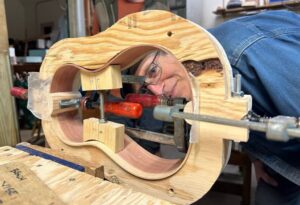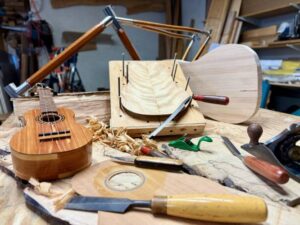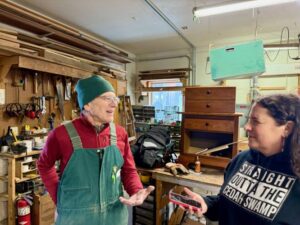
John Fabel in the workshop examining the author’s red cedar ukulele. Photo by CHRISTINE HATCH
If a tree falls in the forest, and nobody is around to hear it, does it make a sound? Well, it most certainly can! Local luthier, inventor, and teacher John Fabel has been making instruments out of the finest fallen trees for years now, giving new meaning to “made local”. I spent 16 months apprenticing with John as part of a community instrument-making endeavor, during which time I produced possibly the first ever ukulele to be made of Eastern Red Cedar (Juniperus virginiana). I also learned a lot about John’s reverence for trees, community, and structural biomaterials throughout the process and the interview I conducted for this article.
John grew up in Western Mass, climbing and loving the trees here, which he values highly just for the pleasure they provide while they’re standing and alive. Making instruments is “a way of getting to know [trees that] requires an intimate appreciation of what happened to get this to come into being.” One of the reasons he returned to the area and lives here today is due to his commitment to his roots, to this Valley, and to push back against the commodification of place. If a place is merely a location to extract a resource, we are less likely to deeply care for it. “I think back on wood,”John says, “ and I think: ‘it takes a forest to create this material, and it takes not just stands of trees, it takes the forest, all of the forest; and the soil, the subsoil, the rocks under the soil, the fungi in the soil, all the way down the chain of the ecosystem.’ It takes the whole complexity of the ecosystem to enable these remarkable materials… musical instruments [are] a celebration of the forest, a celebration of these ecosystems, because – look at this remarkable thing!”
John is not only a luthier. He is also an autodidact engineer and materials scientist, who is always experimenting. For many engineering applications, the most desirable materials are light, stiff and resilient – but most materials only possess two of those properties. Wood, it turns out, excels at all three. John points out that a tree’s structure holds up its mass all day, swaying in the breeze, withstanding storms, for years and decades; so of course it makes a good material that is resilient to repeated vibrations while remaining strong. The same principle holds for bicycle frames, which John also makes from reclaimed wood.

John Fabel’s workshop (back right to front left): A mahogany wood bicycle frame, hemlock bass guitar, a ukelele back made from curly yellow birch recovered from a dumpster, the author’s finished red cedar ukulele, and a ukelele top from a repurposed cedar utility pole on top of a piece of spalted maple. Photo by RICARD TORRES-MATELUNA
For a piece of wood to possess the ideal properties to become an instrument, it must be cut in the orientation aligned with the strongest fibers of the wood. With the perfect cut, you’ll see the silking, or the medullary rays, which means it’s cut right on the plane of the fibers. To cut pieces in the right orientation and large enough for instruments, luthiers often prefer whole trees. John especially likes reclaiming wood from fallen trees, because seeing where the tree has fractured allows him to observe the wood’s natural cleavage and assess its grain. Over the years, he’s developed a “wood eye” for the highest quality woods that will look the most beautiful when finished, and be light and strong enough for good instrument resonance. He collects unusual specimens with spalting (a fungal intrusion that leaves black curls throughout the wood), silking, curling, and tight, old-growth grain. He may cut and test a piece to make sure it has the properties he wants before storing it in his “pantry” for a project someday. He notes, “This is a really esoteric little corner of the universe that we’re talking about here. …it ties into the ways of thinking and the way in which we use the materials, the way in which we appreciate the materials, and the larger web of the world they’re connected to is part of the magic.”
Most of the northeastern hardwoods cut in our area become firewood, perhaps the lowest common use. What would it be like if we added value to what we extract from the forest? Since we have the local skill base, what if, instead of a few dollars of firewood, we made $1000 worth of ukulele, or $3000 worth of guitar? John nurtures a community of musicians among his makers – some people play around on instruments in progress while others fabricate. From the Cherry (Prunus), Red Cedar (Juniperus virginiana), Hemlock (Tsuga canadensis), Yellow Birch (Betula alleghaniensis), Sugar Maple (Acer saccharum) White Pine (Pinus strobus) and Spruce (Picea) trees that have fallen around his neighborhood in the last few years, John and his neighbors, friends and apprentices have made soprano and tenor ukuleles, guitars of various shapes and sizes, cellos, mandolins and electric bass guitars. They know that just because nobody has ever made an instrument from a wood before doesn’t mean it’s not worth trying.
That’s why I like using woods that come from our Valley, because we’re blessed with remarkable woods. And there’s something about maintaining that connection, honoring it, honoring yourself and your people. This wood, this resource, is part of our local identity. it’s a celebration of that when you create something that can make music, that allows us to make music together. That’s what we make when we work together to make the instruments with artists like John. We’re building on that history, and essentially creating an ecosystem, a social ecosystem that ties us to the forest, and ties us to our land.

John Fabel in the workshop explaining biomaterials. Photo by RICARD TORRES-MATELUNA
Christine Hatch (she/her) is research-extension Liaison for the Center for Agriculture, Food and the Environment, and Extension Professor of Water Resources and Climate Change in the Earth, Geographic, and Climate Sciences Department at University of Massachusetts Amherst. She works on ecohydrology, river flooding, and wetland restoration of cranberry bogs.
Earth Matters has been a project of the Hitchcock Center for the Environment for 15 years. HCE’s mission is to educate and to inspire action for a healthy planet. Our Living Building and trails are open to all at 845 West St. in Amherst. To learn more, visit hitchcockcenter.org.
Share this page with friends!